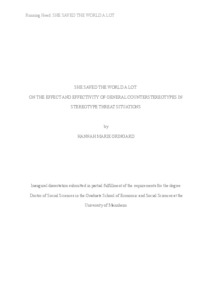|
She saved the world a lot: On the effect and effectivity of general counterstereotypes in stereotype threat situations
Gringard, Hannah Marie
![[img]](https://madoc.bib.uni-mannheim.de/41927/1.hassmallThumbnailVersion/She%20saved%20the%20world%20a%20lot_Gringard_23_03.pdf)  Vorschau |
|
PDF
She saved the world a lot_Gringard_23_03.pdf
- Veröffentlichte Version
Download (1MB)
|
|
URL:
|
https://madoc.bib.uni-mannheim.de/41927
|
|
URN:
|
urn:nbn:de:bsz:180-madoc-419270
|
|
Dokumenttyp:
|
Dissertation
|
|
Erscheinungsjahr:
|
2017
|
|
Ort der Veröffentlichung:
|
Mannheim
|
|
Hochschule:
|
Universität Mannheim
|
|
Gutachter:
|
Dickhäuser, Oliver
|
|
Datum der mündl. Prüfung:
|
22 März 2017
|
|
Sprache der Veröffentlichung:
|
Englisch
|
|
Einrichtung:
|
Außerfakultäre Einrichtungen > GESS - CDSS (SOWI)
Fakultät für Sozialwissenschaften > Pädagogische Psychologie (Dickhäuser 2008-)
|
|
Fachgebiet:
|
150 Psychologie
|
|
Normierte Schlagwörter (SWD):
|
Stereotyp , Vorbild , Training
|
|
Freie Schlagwörter (Deutsch):
|
Bedrohung durch Stereotype , Anti-stereotype , Vorbilder , Antistereotyp-Training , Arbeitsselbst , Stereotypaktivierung
|
|
Freie Schlagwörter (Englisch):
|
Stereotype threat , counterstereotypes , role models , counterstereotypic association training , automatic stereotype activation , working self
|
|
Abstract:
|
The theory of stereotype threat describes situations in which members of stereotyped groups often confirm the negative stereotype through their performance or behavior, for example when heightened anxiety is reflected in poorer performance. This threat effect is moderated by individual and situational factors, which are often translated into interventions. One of these factors is the exposure to counterstereotypes. Prior research for example shows that domain specific role models buffer against threat effects. The focus of this dissertation is the use of general counterstereotypes in stereotype threat situations. Kawakami, Dovidio and van Kamp (2005) developed a training to reduce gender stereotypes. This training, called the Counterstereotypic Association Training, asks participants to match stereotypically male and female words to images of men and women in such a way that word and image do not stereotypically match. To test the effectivity and the effect of the training, three studies were conducted. Study 1 tests the effectivity of the training in a stereotype threat situation (mathematics). 104 girls between the ages of 16 and 20 were asked to complete the Counterstereotypic Association Training or a Control Training before completing an arithmetic test. Additionally, half of the participants were induced with stereotype threat resulting in a 2x2 (Counterstereotypic Association Training vs. Control Training x Threat vs. No Threat). Results show the Counterstereotypic Association Training to effectively moderate stereotype threat: participants who did not receive the training performed significantly worse than participants in the three remaining groups. Study 2 put the focus on the mechanism behind the effect of the Counterstereotypic Association Training. We proposed three mechanisms through which the training potentially buffered threat effects. These three mechanisms were tested in a sample of 60 students of the University of Mannheim who either completed the Counterstereotypic Association Training or the Control Training. Subsequently reaction latencies were taken for self-describing masculine of feminine trait words. Participants of the Counterstereotypic Association Training reacted more slowly to gendered trait words than participants in the Control Training group. Additionally, participants in the Counterstereotypic Association Training group did not react more quickly to either gender while participants in the Control Training group reacted faster to feminine trait words than masculine ones. The goal of study 3 was to test the endurance of the mechanisms in stereotype threat situations. 203 students from the University of Mannheim were asked to complete a reaction time task (same as study 2) at three time points during the course of the experiment. Additionally half completed the Counterstereotypic Association Training while the other half finished the Control Training. Participants were also either induced with stereotype threat or not, overall leading to a 2x2 design (Counterstereotypic Association Training vs. Control Training x Threat vs. No Threat). Results from study 1 were replicated. The longitudinal data of the reaction time measure show differences to study 2. Participants who finished the Counterstereotypic Association Training reacted more slowly to gendered trait words than participants in the Control Training condition both after the training and the arithmetic task. Participants in both groups however reacted more quickly to feminine trait words than masculine trait words after having finished either training. Implications of the results and recommendations for further research will be discussed.
|
|
Übersetzter Titel:
|
Sie hat die Welt oft gerettet: Über den Effekt und die Effektiviät von allgemeinen Antistereotypen in Stereotype Threat Situationen
(Deutsch)
|
 | Dieser Eintrag ist Teil der Universitätsbibliographie. |
 | Das Dokument wird vom Publikationsserver der Universitätsbibliothek Mannheim bereitgestellt. |
 Suche Autoren in Suche Autoren in
Sie haben einen Fehler gefunden? Teilen Sie uns Ihren Korrekturwunsch bitte hier mit: E-Mail
Actions (login required)
 |
Eintrag anzeigen |
|
|
